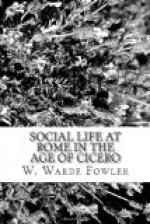Across the bay, and just within view from the higher ground between Baiae and Cumae, lay the little town of Pompeii, under the sleeping Vesuvius. Here, probably just outside the town, Cicero had a villa of which he seems to have been really fond, and the society of a quiet and gentle friend, M. Marius. Whether we can find the remains of this villa among the excavations of Pompeii is very doubtful: but our excellent guide Schmidt assures us that he has good reason for believing that one particular house, just outside the city on the left side of the road in front of the Porta Herculanea, which has for no very convincing reason ever since its excavation in 1763 been called the Villa di Cicerone, really is the house we wish it to be. But alas! an honest man must confess that the identification wants certainty, and the chance of finding any object or inscription which may confirm it is now very small.
If Cicero were summoned suddenly back to Rome for business, forensic or political, he would hasten first to Formiae and sleep there, and thence hurry, by the via Appia and the route so well known to us from Horace’s journey to Brundisium, to another house in the little sea-coast town of Antium. This was his nearest seaside residence, and he often used it when unable to go far from Rome. After the death of his daughter in 45 he seems to have sold this house to Lepidus, and, unable to stay at Tusculum, where she died, he bought a small villa on a little islet called Astura, on the very edge of the Pomptine marshes, and in that melancholy and unwholesome neighbourhood he passed whole days in the woods giving way to his grief. Yet it was a “locus amoenus, et in mari ipso, qui et Antio et Circeiis aspici possit.[404]” It suited his mood, and here he stayed long, writing letter after letter to Atticus about the erection of a shrine to the lost one in some gardens to be purchased near Rome.
This sketch of the country-houses of a man like Cicero may help us to form some idea of the changeful life of a great personage of the period. He did not look for the formation of steady permanent habits in any one place or house; from an early age he was accustomed to travel, going to Greece or Asia Minor for his “higher education,” acting perhaps as quaestor, and again as praetor or consul, in some province, then returning to Rome only to leave it for one or other of his villas, and rarely settling down in one of these for any length of time. It was not altogether a wholesome life, so far as the mind was concerned; real thought, the working out of great problems of philosophy or politics, is impossible under constant change of scene, and without the opportunity of forming regular habits.[405] And the fact is that no man at this time seriously set himself to think out such problems. Cicero would arrive at Tusculum or Arpinum with some necessary books, and borrowing others as best he could, would sit down to write a treatise on ethics or rhetoric with amazing speed,




